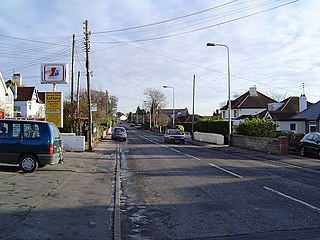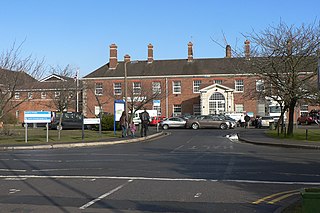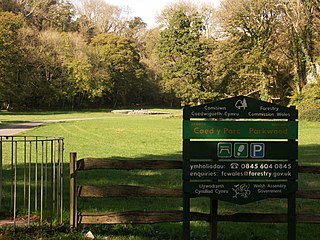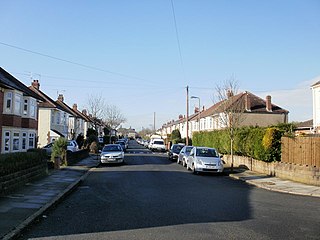
The Vale of Glamorgan, often referred to as The Vale, is a county borough in the south-east of Wales. It borders Bridgend County Borough to the west, Cardiff to the east, Rhondda Cynon Taf to the north, and the Bristol Channel to the south. With an economy based largely on agriculture and chemicals, it is the southernmost unitary authority in Wales. Attractions include Barry Island Pleasure Park, the Barry Tourist Railway, Medieval wall paintings in St Cadoc's Church, Llancarfan, Porthkerry Park, St Donat's Castle, Cosmeston Lakes Country Park and Cosmeston Medieval Village. The largest town is Barry. Other towns include Penarth, Llantwit Major, and Cowbridge. There are many villages in the county borough.

Glamorgan, or sometimes Glamorganshire, is one of the thirteen historic counties of Wales and a former administrative county of Wales. Originally an early medieval petty kingdom of varying boundaries known in Welsh as the Kingdom of Morgannwg, which was then invaded and taken over by the Normans as the Lordship of Glamorgan. The area that became known as Glamorgan was both a rural, pastoral area, and a conflict point between the Norman lords and the Welsh princes. It was defined by a large concentration of castles.

Penarth is a town and community in the Vale of Glamorgan, Wales, approximately 3 miles (4.8 km) south of Cardiff city centre on the west shore of the Severn Estuary at the southern end of Cardiff Bay.

Sully is a village in the community of Sully and Lavernock, in the Vale of Glamorgan, Wales, lying on the northern coast of the Bristol Channel, midway between the towns of Penarth and Barry and 7 miles southwest of the Welsh capital city of Cardiff.

Grangetown is a district and community in the south of Cardiff, capital of Wales. It is one of the largest districts in the south of the city and is bordered by Riverside, Canton and Butetown. The River Taff winds its way through the area. Adjacent to the city's Cardiff Bay area, Grangetown is experiencing a period of gentrification and improvements in its infrastructure. Its population as of 2011 was 19,385 in 8,261 households. One of the "five towns of Cardiff", the others are Butetown, Crockherbtown, Newtown and Temperance Town.

Llandough is a village, community and electoral ward in the Vale of Glamorgan, Wales, approximately 2.3 miles (3.7 km) south west of Cardiff city centre, and approximately 1.3 miles (2 km) north west of Penarth.

Park House, 20 Park Place, Cardiff, Wales, is a nineteenth century town house. It was built for John McConnochie, Chief Engineer to the Bute Docks, by the Gothic revivalist architect William Burges. It is a Grade I listed building. The architectural historian John Newman writes that the architectural style of the house "revolutionized Cardiff's domestic architecture," and Cadw considers the building "perhaps the most important 19th century house in Wales."

Parc le Breos was a great medieval deer park in the south of the Gower Peninsula, about eight miles (13 km) west of Swansea, Wales, and about 1+1⁄4 miles (2.0 km) north of the Bristol Channel. The park was an enclosed, oval area of 6.7 miles (10.8 km) in circumference, covering about 2,000 acres (810 ha) and measuring 2+1⁄2 miles (east–west) by just over 1+3⁄4 miles. Parc le Breos was established in the 1220s CE by John de Braose, Marcher Lord of Gower and husband to Margaret Ferch Llywelyn, Llywelyn Fawr's daughter. Other than for deer husbandry, the park received an income from agistment, pannage, and from sales of wild honey, ferns and dead wood. There is evidence of rabbit warrens in the park. Whether the warrens were free or domestic is unknown.

St Augustine's Church is a Grade I-listed Gothic Revival nineteenth-century parish church in Penarth, Vale of Glamorgan, Wales.

Thomas Alwyn Lloyd, known as T. Alwyn Lloyd, was a Welsh architect and town planner. He was one of the founders of the Town Planning Institute in 1914 and its President in 1933. He was also a founding member of the Council for the Protection of Rural Wales in 1928 and served as its chairman from 1947 to 1959. Meic Stephens described Lloyd's work as follows:
Lloyd's small-scale buildings reflected his deep feeling for place, in both historical and environmental terms, as in the Garden Villages for which he was responsible in various parts of Wales.
Llantrithyd is a rural village and community in the Vale of Glamorgan, Wales. The Aubrey Baronets were lords of the manor of Llantrithyd for centuries: the family died out in the 1850s.

There are many listed buildings in Penarth, a seaside town in the Vale of Glamorgan, Wales. Penarth was popular with holidaymakers from far afield, but also a popular place to live for the wealthy business owners of Penarth and nearby Cardiff. The town has a wealth of Victorian and Edwardian architecture.

St. Brides-super-Ely is a village and district of the community of Peterston-super-Ely, within the Vale of Glamorgan, South Wales. It is located near the western border of the Welsh Capital City of Cardiff, to the west of the A4232, and north of the River Ely.

St Michael's is a Roman Catholic church in Pillgwenlly in Newport, Wales. It located at the corner of Clarence Street and St Michael Street. St Michael's has been Grade II listed since January 1997.
Vaendre Hall is a large detached house in the Cardiff suburb of St Mellons.

Ty Gwyn is a large detached house in the Cardiff suburb of Lisvane. It is set in 5 acres of grounds and is 10,000sq ft in size.

St-y-Nyll is a large detached house near the village of St. Brides-super-Ely in the Vale of Glamorgan.
Wydham Park is an uncompleted planned village in Peterston-super-Ely in the Vale of Glamorgan. It was the first garden suburb in Wales.
Ivan Dale Owen was a Welsh architect in the modernist architectural style. The Glamorgan Archives and The Independent newspaper both described him as a 'leading figure in Welsh architecture'. He was a partner in the Percy Thomas Partnership before setting up his own architectural practice with his wife in Penarth in 1989. Among Owen's designs were BBC Broadcasting House, Cardiff, the entrance building and galleries of St Fagans National Museum of History, Cardiff, plus major developments at Cardiff University, Swansea University and Aberystwyth University.

The Vale of Glamorgan is a county borough in south-east Wales. It covers an area of 331 km2 (128 sq mi) and in 2021 the population was approximately 132,500.
















